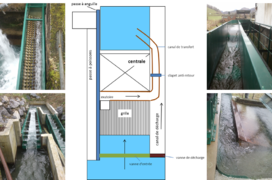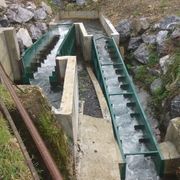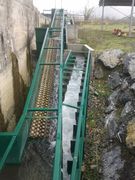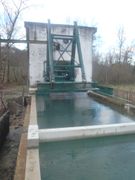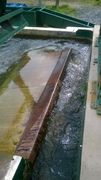Difference between revisions of "Trois Villes test case"
Bendikhansen (talk | contribs) |
Bendikhansen (talk | contribs) |
||
| Line 61: | Line 61: | ||
=Gallery= | =Gallery= | ||
NOTE: edit description for the picture with the gate or whatever that is [[file:broken]] | NOTE: edit description for the picture with the gate or whatever that is [[file:broken]] | ||
| − | <gallery mode=packed widths= | + | <gallery mode=packed widths=500px> |
Devices-for-upstream-and-downstream-migration-at-Trois-Villes.png|Overview of fish migration measures at Trois Villes. | Devices-for-upstream-and-downstream-migration-at-Trois-Villes.png|Overview of fish migration measures at Trois Villes. | ||
trois_ville_baffle_fishway.jpg|The baffle fishway at Trois Ville hydropower plant. | trois_ville_baffle_fishway.jpg|The baffle fishway at Trois Ville hydropower plant. | ||
Revision as of 12:31, 11 March 2020
| Fact box: Trois Ville | |
|---|---|
| Country | France |
| River | Saison |
| Operator | Société Hydroélectrique de Gotein |
| Capacity | 0.16 MW |
| Head | 5 m |
| Inter-annual discharge | 22.3 m3/s |
| Turbine(s) | 1 Kaplan turbine |
| Detailed report | Click for pdf |
Contents
Introduction
The hydropower plant (HPP) Trois-Villes is located on the Saison in the southwest of France. The Saison is 54 km long. It flows in southwest of France near the Pyrenees. It flows into the Gave D’Oloron, which then flows in the Adour River. Altogether, there are 3 HPP on the water body and one fish farm.
The hydrology of the Saison is characterized by sustained flows in winter, high water levels in spring due to snow melting and a low water period from August to October. At Trois-Villes the mean interannual discharge is estimated at 22.3 m3/s.
About the hydropower plant
Trois Ville is run-off-river HPP with a 1.3 km long bypass reach. It has an installed capacity of 0.16 MW. The turbine on site is a Kaplan Turbine (Maximum turbined flow: 4.1 m3/s, Rated head: 5 m)
The Operator: Société Hydroélectrique de Gotein
The HPP Trois Villes is operated by the Société Hydroélectrique de Gotein, which is a small company responsible for operating two small HPP.
Pressures on the water body's ecosystem
The hydrology of the Saison is highly altered by the hydropower plant of Sainte-Engrâce located more than 25 km upstream, which runs with hydropeaking. The continuity is altered by the several weirs and HPPs along its course.
Test case topics
Fish population
The river is dominated by cyprinids and salmonids.
Downstream migration
To prevent fish from passing into the turbines an inclined bar rack is located in front of the hydropower plant with a width of 6.36 m, a bar spacing of 20 mm and an angle of 26° to the horizontal.
Upstream migration
At the dam, the fishes can use a pre-barrage fish pass to go upstream (2014). In the fish pass, a flow of 1 m3/s is maintained. The fish pass has three pools of 44, 49 and 62 m2 size. The dissipated energy in the pools is between 72 W/m3 in low flow water periods and 196 W/m3 when the discharge is 2 times the mean interannual discharge (?44 m3/s).
At the power plant a baffle fish pass was built in 2014. It has a slope of 16% and maintains a flow of 150 l/s. It consists of a succession of 5 portions of baffle (0.5 x 7.5 m) connected by pools of 3 x 2 x 1 m. It allows salmonids to go upstream. There is a specific device for eels: it is composed of 2 portions of 3 and 9 m length and a slope of 25 to 30 %, connected by resting pools (1.5 x 1.0 x 0.5 m). The flow allocated to the fish pass is only a few liters per second. These devices target the fish using the tailrace channel to go upstream.
E-flow
In France, the law of 2006 (LEMA) imposes an e-flow of 1/10 of the mean inter-annual discharge before 1rst January 2014. They are two options for the environmental flow in the bypass section. In Trois-Villes, the discharge value is 2.5 m3/s, it’s bigger than 1/10 of the mean interannual discharge and doesn’t come from a biological study. It comes from a previous regulation (decree from January 1990) and wasn’t change.
Research objectives and tasks
The test case site of Tois-Villes is a small HPP with a fishfriendly water intake. It is planned to assess the efficiency of this water intake. Hydraulic modelling will be done for the entrance of the HPP to assess the influence of the bypass and undertake modifications of the flow conditions. Through further hydraulic modeling of the water course, the effect of the power plant on the habitat will be assessed.
Research tasks
Results
The Trois-Villes test case consists in a small HPP with a fish friendly water intake. Most of the current design recommendations are respected on this test case for both upstream and downstream migration. The configuration of Trois-Villes is quite specific because of the presence of the dump channel. Its entrance is located in a calm area upstream of the trash rack, in which the fishes stable. The dump valve regularly opened during the study, suddenly and for short durations. This test case is used for evaluating the efficiency of an inclined low bar spacing trashrack and for validating the discharge calculated using 3D modelling inside the bypasses as well as the tangential and normal components of the upstream velocity. ADCP measurements have been used to monitor the discharge of the HPP. The tangential and normal components of the velocity have been measured with ADCP and are in good agreement with the 3D numerical modelling. Pit-tag measurements have been carried out on six batches of 50 smolts over days during which the discharge varied. Fishes were released in the headrace channel and used different paths ways to migrate downstream. 30.7% of the fishes went through the dump channel when the valve opened. In average, 61% of the fishes went through the downstream migration device and 0.7% used the fish pass. The total survival rate is 99.23%.
| Dam | Power plant | Total survival rate at Trois-Villes | |||
|---|---|---|---|---|---|
| Proportion of fishes passing over the spillway of the dam | Proportion of fishes led to headrace channel | Proportion of fishes passing through the turbine | Mortality through the turbine | Proportion of fishes assumed dead due to passage through the turbine | |
| 8.4 % | 91.6 % | 7.02 % | 11 % | 0.77 % | 99.23 % |
The table above is a summary of the distribution of fishes passing through the different ways: passage rate through the turbines (this study) and their mortality rates , and global passage efficiency taking into account passage over the spillway, the downstream migration device and survival after passage through turbines (Tomanova, et al., 2018)
Gallery
NOTE: edit description for the picture with the gate or whatever that is File:Broken
